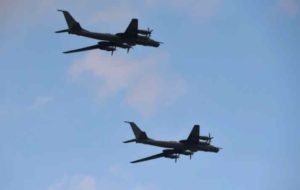
WASHINGTON — The appearance of two Russian and two Chinese long-range, strategic bombers in the skies off of coastal Alaska may have been a first, but it did not catch the United States off-guard.
U.S. Defense Secretary Lloyd Austin told reporters Thursday the appearance of the Russian and Chinese aircraft “was not a surprise” and that at no time did the bombers pose a threat to the United States.
“We have very good surveillance capabilities,” Austin said during a rare news conference at the Pentagon. “We closely monitored these aircraft, tracked the aircraft, intercepted the aircraft, which demonstrates that our forces are at the ready all the time.”
And if Russia and China fly more similar missions in the future, Austin said he has every confidence that U.S. forces will be prepared.
“We are at the ready. We will always be at the ready,” he said. “If there is a challenge or a threat to the United States of America, your troops will be at the ready and they will do the right thing.”
NORAD tracks aircraft
The North American Aerospace Defense Command (NORAD) first shared word of the Russian and Chinese military activity late Wednesday.
NORAD said it tracked two Russian TU-95 bombers and two Chinese H-6 bombers operating in the U.S. Air Defense Identification Zone (ADIZ) — a stretch of international airspace where planes must be identified — off the coast of the northwestern state of Alaska.
A statement said U.S. and Canadian fighter jets were sent to intercept the Russian and Chinese planes, and that at no time did the Russian or Chinese pilots enter U.S. or Canadian sovereign airspace.
“This Russian and PRC activity in the Alaska ADIZ is not seen as a threat, and NORAD will continue to monitor competitor activity near North America and meet presence with presence,” it said.
Flight was joint patrol, say Russia and China
Russia and China on Thursday described the flight as a joint patrol over the Chukchi and Bering seas in the north Pacific.
“During the flight, Russian and Chinese crews cooperated in the new area of joint operations during all stages of the air patrol,” the Russian ministry said in a statement, describing the exercise as “part of the implementation of the military cooperation plan for 2024.”
Russian officials said the entire flight lasted five hours and that the bombers were at times escorted by Russian fighter jets, emphasizing that at no time did the bombers violate U.S. or Canadian airspace.
A spokesperson for the Chinese military said the patrol was designed to improve coordination between the Chinese and Russian militaries, and said it was the eighth joint air patrol since 2019.
The U.S., however, said the Russian-Chinese air patrol was the first to approach the area around Alaska.
“This is the first time we’ve seen those two countries fly together like that,” Austin told reporters, adding the Russian and Chinese bombers never got closer than about 320 kilometers from the Alaskan coast.
The U.S. defense secretary declined to comment on the timing of the Russian-Chinese air patrol, though he said, “you could probably guess that things like that have probably been planned well in advance.”
Earlier this week, the Pentagon issued its new Arctic defense strategy, which called for increased investment and increased cooperation among the U.S. and its Arctic allies to counter both Russian and Chinese activity.
The U.S. and its NATO allies have also raised concerns about growing cooperation between Russia and China, along with Iran and North Korea, as Moscow has sought support for its war in Ukraine.
U.S. and Western officials have repeatedly accused China of playing a critical role in sustaining Russia’s military by sending Russia raw materials and so-called dual-use components needed to produce advanced weapons and weapons systems.
“There is no time to lose,” a NATO official told VOA earlier this month, speaking on the condition of anonymity to discuss the need to counter the growing defense cooperation.
“This must be a key priority for all our allies, because it is not just about spending more,” the official said. “It is also on getting those capabilities.”
Source: VOA
